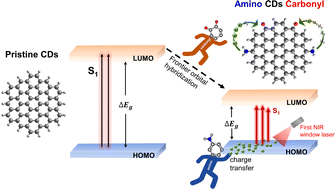Revealing the synergetic interaction between amino and carbonyl functional groups and their effect on the electronic and optical properties of carbon dots†
Abstract
Nitrogen and oxygen-based functionalized carbon dot (CDs) surfaces have attracted significant attention due to their ability to tailor the optical and electronic properties of CDs. However, the complex synthesis process and structure of the functionalized CDs hinder an in-depth understanding of their mechanism, limiting their potential applications. Herein, we report CDs functionalized with amino and carbonyl functional groups and reveal the mechanism of interaction between the amino and carbonyl groups and the CDs' optical and electronic properties. Both Time-dependent Density Functional Theory (TD-DFT) and experimental studies revealed that the synergetic effects between amino and carbonyl groups significantly shift the absorption peaks to the NIR region and strengthen their absorption intensity. Furthermore, their absorption and bandgap energy could be tuned by optimizing the amino to carbonyl ratio on CDs surfaces. This study suggests that amino and carbonyl groups synergistically tailor the CDs’ optical and electronic properties through frontier orbital hybridization and high charge transfer. This knowledge opens a new avenue for tailoring the desired optical and electronic properties of CDs for any application.



 Please wait while we load your content...
Please wait while we load your content...